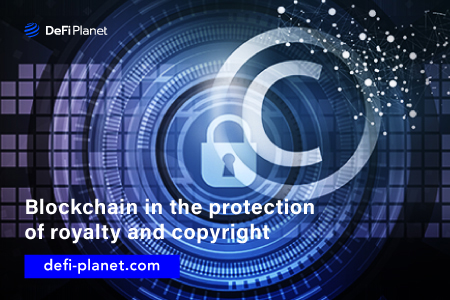Last updated on June 21st, 2023 at 04:47 pm
Blockchain is a multi-purpose technology that has different applications. One of such applications is its use in the protection of royalty and copyright.
This article talks about the challenges of the existing Intellectual Property Rights (IPR) system and how blockchain technology can make it more efficient.
Let’s dive in!
Intellectual Property In The Modern World: An Overview
According to the letter of the law, when you create anything from music to a piece of writing or even a photograph, you own it. However, this is not the case when it is your word against someone else’s. In such a scenario, an official document or timestamp is needed in order to prove that it’s your work. The lack of an official document that could prove which version is the original work makes copyright little more than a vanity.
How do you tackle such a situation?
Since your creation is a piece of creative work, there is no standard way to legitimize the ownership of the work before its publication. For instance, if you were an inventor, you could simply go to the patent office and get your work protected.
The problem of not being able to protect creative work has only gotten worse with the advent of the internet as the challenges related to copyright protection have grown bigger. This is because as so many people interact with the internet on a daily basis, it has resulted in a huge repository of data online, surfing through which just isn’t possible. Moreover, since all the work is readily available online, anyone can simply download your work for personal use without the creator’s knowledge or permission.
What can a creator do in such a situation?
Unfortunately, there isn’t much to be done in this case as it is complicated to prove ownership of the work. While it might be a little easier to get compensated when the IP has been used for commercial purposes, even then, the burden is on the creator to prove ownership and enforce their rights. However, this can be a lengthy and expensive process.
Thankfully, all this can potentially change in the future with the advent of blockchain technology, which can help creators defend their intellectual property.
How? It is possible because, in contrast to legacy systems built on single-party record keeping, blockchain technology enables the creation of digital, decentralized, and open to all platforms that can be used to manage digital assets.
Challenges With The Current System
There are many challenges and issues with the current system of royalty and copyright protection. These issues are primarily associated with the administration and distribution of works. Let’s take a look:
- Lack of reliable information on ownership – The absence of formalities in copyright rules makes it difficult to identify the current right holder. The problem is even worse when it comes to older works, when the rights to the work have been passed to another individual, or when work has several rights holders.
- Fragmentation of ownership – A copyright gives the copyright owner many exclusive rights over the protected work, such as the right to reproduce, distribute, or publicly perform the work. As a result, copyright is frequently referred to as a bundle of rights. Because these rights are divisible, a right holder can transfer not only the copyright in its entirety but also one or more of the exclusive rights. Furthermore, each of the exclusive rights can be owned by multiple people, with different quotes for them. When the work in question has multiple copyrights, the situation gets much more complicated.
- Lack of transparency in content usage and payments – Another problem is the lack of transparency in tracking the use of works and incoming payments as a foundation for calculating and distributing royalties. This mainly impacts owners of intellectual property, particularly artists. Right holders frequently do not receive information on how often their works are utilized or generated revenues, which hinders them from validating royalty calculations. Furthermore, right holders do not have access to information about content usage, such as where and how their works are used.
- Inequality in revenue distribution – As there are many intermediaries involved who have a share in the revenue, there are a lot of problems associated with creating a fair revenue distribution system.
- Piracy – Digital works can be duplicated and distributed on the Internet for almost little money and without sacrificing quality. Piracy primarily affects right holders who can no longer effectively manage how their works are used, resulting in a loss of money.
How Blockchain Technology Can Be Used To Protect Intellectual Property
The modern way has a knowledge economy where many business values are derived from intangible assets. As a result, the success of a business largely depends on the company’s ability to manage and exploit intellectual property (IP). To do so, companies must have people who are adept at acquiring, governing, and commercializing copyright and patent-protected content.
This is easier said than done because of the different issues in the current system. However, with the introduction of blockchain and blockchain-enabled tools that can represent unique assets and manage the development and payments systems for intellectual property, there is potential to create a more efficient system in the future.
The benefits of using blockchain technology to create such a system for rights and royalties management are as follows:
- Improved management of provably unique intangible assets – A shared asset’s copyright ownership can be proven, and attribution may be traced back to the parties that created it. Various teams can cooperate and iterate on the material using existing tools while keeping provenance and credit for output. The usage of blockchain technology, on the other hand, allows for the commoditization of assets that may be reused, swapped, and given a monetary value.
- Reduced friction associated with transactions using a peer-to-peer network – The network shares transactions and value movements, minimizing transaction stages in the licensing and contract management processes. A layer of smart contracts automates dependent transactions, alerts relevant third parties, and quickly calculates the financial obligation as real-world inputs are recorded.
- Enhanced partnership relationships using blockchain’s distributed ledger technology – Multiple parties frequently demand access to media assets, contract terms, and transaction audit logs. The audit function repeated by numerous company partners only has to happen once when using a shared ledger. Thanks to custom applications and interaction with existing IT systems, self-service reporting is also possible with the platform.
Having understood some of the benefits of using blockchain in the protection of royalty and copyright, let’s look at some of the use cases:
- (Block-)Chain of Title – Ownership information can be found in a registry that chronicles the creation of works. This would not only make the rights clearance procedure easier for potential users, but it would also help evaluate whether or not a work is still protected under copyright law. Copyright holders can use a copyright register to show ownership of their works. To overcome the problem of out-of-date registrations, all transfers of rights should be recorded in addition to the initial creation of a work. The features of such a blockchain-based copyright register include the following:
- Availability of Comprehensive and Reliable Ownership Information – The clearance of rights could be facilitated by a blockchain-based copyright register that ensures full and reliable information about works and rights holders. Right holders may be able to verify their ownership of work through reliability and transparency. A registry containing information on the author, the date of creation, and the date of publishing of the work can also assist users in determining whether or not a work is still protected by copyright law.
- Tokenization of Works and Rights – Copyright-protected works can also be transformed into tokens, transferable digital representations of assets on the blockchain. The work itself, a copy of the work, or special rights can all be represented by these tokens.
- Usage Control – A blockchain-based copyright register can also assist right holders in controlling the use of their works.
- Smart Licenses: Transfer of rights through smart contracts – In addition to storing ownership data, blockchain technology may also be used to provide a framework for the exchange of ownership via smart contracts. The features of a transfer of rights through smart contracts include the following:
- Enable direct transfers of rights between right holders, and users – The transfer of rights can be carried out directly between right holders and potential users, such as exploiters or consumers, utilizing smart contracts. A right holder can set the price and other terms ahead of time, and a likely user can get these rights without negotiating. Furthermore, transferring rights via smart contracts can reduce correct clearance transaction costs.
- Allow right holders to control pricing and other conditions – Smart contracts allow intellectual property owners to determine fees and other terms to use their works flexibly and autonomously. Right holders can charge different prices for different copies of their works. For example, a piece of music for personal use may be less expensive than a song with permission to change or use commercially.
- Make tracking of content usage and payments possible – Smart contracts can track content usage and incoming payments. If it is possible to verify the extent to which a work has been used and how much income has been earned, revenue calculation transparency can be improved. Right holders can also assess transaction data and learn more about the people who interact with their work. This information can be used to better target marketing efforts and increase sales.
- Improve revenue distribution – Smart contracts can carry out revenue payments according to the terms set forth by the right holder. A smart contract can automatically share revenues across many rights holders if there are several.
- Create a secondary market for digital content – A blockchain-based copyright registration combined with smart contracts might form the basis of a market for “used” digital content. For example, a buyer of a copyright-protected work stored on a physical medium can transfer the medium to a third party without the right holder’s permission.
Companies Integrating Blockchain In Intellectual Property Use Cases
Many companies have integrated blockchain technology into their Intellectual Property protection systems. Let’s look at some of them.
- Binded – This service is aimed towards smaller creatives and will assist you in determining who is utilizing your IP address online. As proof of ownership, they also provide a Blockchain-based copyright certificate.
- Bernstein Technologies – This Munich-based firm provides a suite of tools for developing and enforcing intellectual property laws for individuals and enterprises. Advanced cryptography protects the trade secrets of more prominent players, and it would be helpful for IT and code development as well.
- Copyrobo – Copyrobo is a fast and economical way to ensure IP ownership using state-of-the-art Blockchain and Quality Authority time-stamping. They provide excellent service while maintaining a high level of security for your registration.
- Bitcoin.com – It’s not quite a full-service solution, but it’s a low-cost and straightforward way to have your IP engraved into the Bitcoin network.
In Conclusion…
- Blockchain technology offers tremendous benefits to the royalty and copyright environment. It is a technology through which content producers, intellectual property owners, distribution partners, and even end-users stand to benefit. This is because by building blockchain-enabled tools that allow users to store and transact intellectual property in a safe and decentralized manner, content producers can enhance and protect their most valuable assets.
So, what are your views on using blockchain technology in the protection of royalty and copyright? Do you believe blockchain can help content producers protect their assets?
Comment below and let us know what you think!
If you would like to read more articles like this, follow DeFi Planet on Twitter and LinkedIn.





















